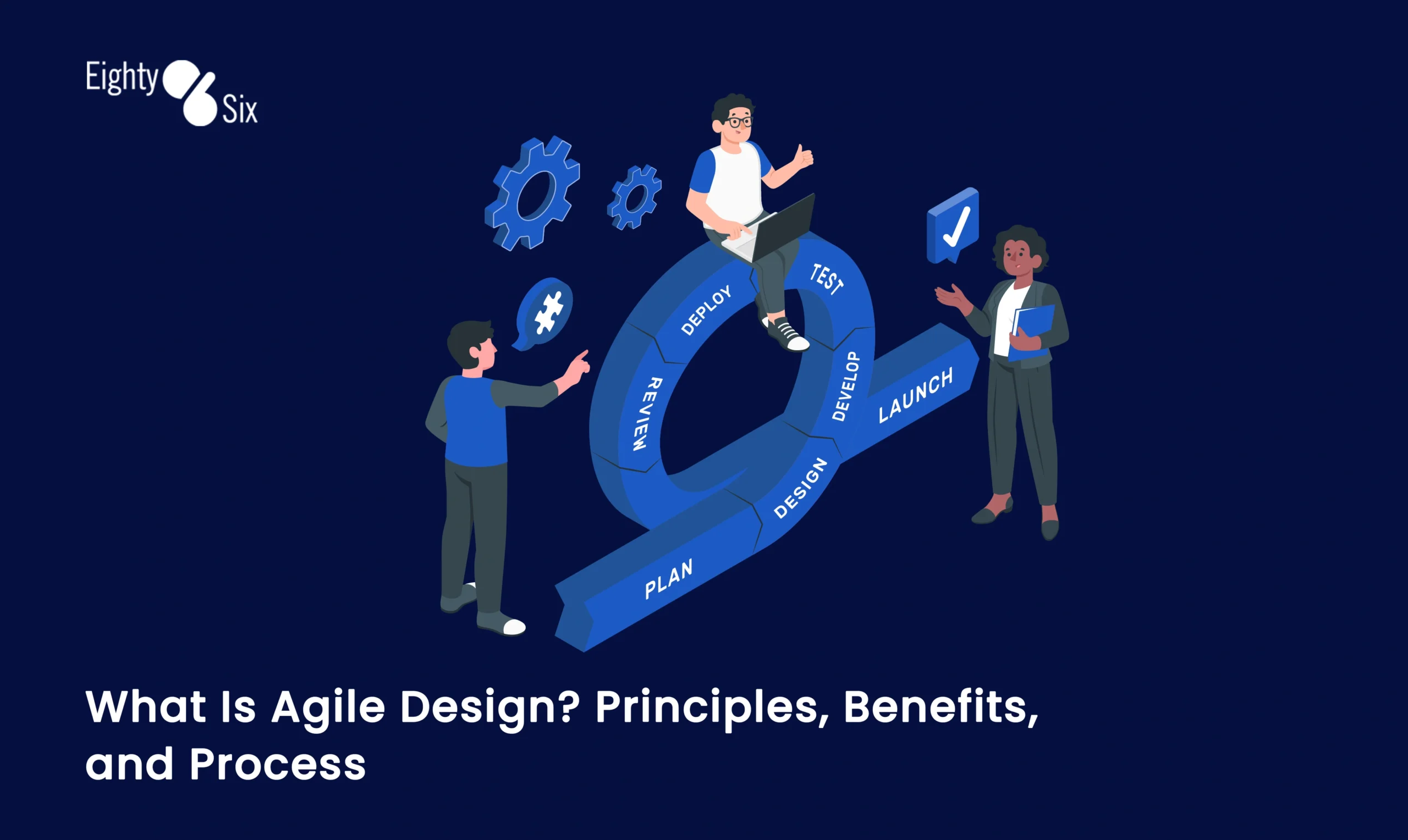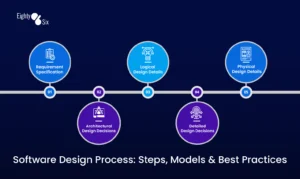What Is Agile Design? Principles, Benefits, and Process

Table of contents
In today’s fast-paced digital era, traditional project management and design methods often fail to keep up with the speed of innovation. Software development, digital product design, and user experience (UX) projects need an approach that thrives on flexibility, collaboration, and continuous improvement. That’s where Agile Design comes into play.
Agile Design is more than a methodology—it’s a mindset that blends agile project management principles with creative design practices. By encouraging collaboration, iterative development, and rapid feedback loops, Agile Design ensures that teams can respond to change quickly and deliver products that truly meet user needs.
In this blog, we’ll take a deep dive into:
- What Agile Design really means
- Core principles guiding Agile Design
- The advantages of agile methodology in design and development
- How Agile fits into a project management plan for software development
- Examples of collaborative workflows and even a software architecture example
- The role of testing phases in software testing in Agile projects
- A step-by-step process for adopting Agile Design
By the end, you’ll not only understand Agile Design but also have actionable insights to apply it in your own projects.
What Is Agile Design?
Agile Design is an approach to product and software development that integrates Agile principles—such as adaptability, collaboration, and incremental progress—into the design process. Instead of treating design as a one-time, upfront stage, Agile Design treats it as a continuous, evolving activity that grows alongside the project.
This concept originated from the Agile Manifesto (2001), which highlighted four key values:
- Individuals and interactions over processes and tools
- Working software over comprehensive documentation
- Customer collaboration over contract negotiation
- Responding to change over following a fixed plan
When applied to design, these values shift the focus from rigid workflows to collaborative software development, constant user feedback, and an adaptive design framework.
Agile Design is not about eliminating structure—it’s about creating just enough structure to support creativity while leaving room for flexibility.
Core Principles of Agile Design
The principles of Agile Design are rooted in Agile methodology but tailored for designers and product teams. Here are the most important ones:
1. Iterative and Incremental Progress
Designs are developed in small increments rather than as a “final draft.” Each iteration is tested, refined, and improved, ensuring better alignment with user needs.
2. Collaboration at Every Stage
Agile thrives on collaborative software development. Designers, developers, testers, and stakeholders work together closely, sharing feedback regularly to avoid silos.
3. User-Centered Mindset
Agile Design emphasizes frequent usability testing and user feedback. By engaging users throughout the journey, products evolve based on real-world needs, not assumptions.
4. Flexibility and Responsiveness
Instead of locking into a rigid blueprint, Agile Design adapts when requirements change. This flexibility reduces wasted effort and ensures relevance.
5. Continuous Testing and Validation
Unlike traditional processes where testing comes last, Agile Design integrates testing phases in software testing at every iteration. This means design flaws or usability issues are caught early.
6. Empowered Teams
Cross-functional teams are given autonomy to make decisions, fostering creativity and accountability.
Agile Methodology Advantages in Design and Development
Why is Agile Design becoming the go-to framework for modern organizations? Here are the top advantages of Agile methodology when applied to design:
1. Faster Time-to-Market
By working in short sprints, teams can launch MVPs (Minimum Viable Products) or beta versions quicker, reducing time wasted on over-engineering.
2. Reduced Risks
Since changes can be introduced at any stage, the risk of delivering an irrelevant or outdated product decreases dramatically.
3. Higher Customer Satisfaction
Frequent collaboration with users ensures the end product aligns closely with customer expectations.
4. Better Collaboration Across Teams
Agile encourages breaking down silos, fostering collaborative software development where designers, developers, and QA testers work seamlessly.
5. Improved Quality
Early integration of testing phases in software testing ensures better quality control, fewer bugs, and enhanced user experiences.
6. Cost Efficiency
Since Agile avoids “big design up front” waste, resources are optimized and rework is minimized.
Agile Design vs. Traditional Design Approaches
| Aspect | Agile Design | Traditional Design (Waterfall) |
| Process Style | Iterative and incremental | Linear and sequential |
| Flexibility | Highly adaptable to change | Rigid, difficult to adapt |
| Collaboration | Cross-functional, continuous feedback | Departmental silos |
| Testing | Integrated in every sprint | Conducted at the end |
| Time to Market | Faster (via MVPs and iterations) | Slower (long upfront design) |
| User Involvement | Active throughout | Limited, mostly at beginning/end |
Agile Design in Project Management Plans
When developing software, design cannot be separated from planning. Agile Design plays a crucial role in shaping the project management plan for software development.
A typical Agile project management plan includes:
- Vision and Objectives: Clear goals tied to user needs.
- Backlog Creation: Prioritized list of design and development tasks.
- Sprint Planning: Each sprint includes design, development, and testing tasks.
- Daily Standups: Teams discuss progress, blockers, and next steps.
- Sprint Reviews and Retrospectives: Evaluate work done, collect feedback, and refine processes.
By embedding Agile Design in this plan, teams ensure that the product evolves seamlessly—from software architecture examples to usability testing—without delays or disconnects.
A Software Architecture Example in Agile Design
To understand how Agile Design supports real projects, let’s look at a software architecture example:
Imagine a team building a cloud-based project management app.
- Iteration 1: Develop the core architecture—user login, authentication, and basic project dashboard. Designers create a simple wireframe tested by early adopters.
- Iteration 2: Add collaboration tools—file sharing, messaging, and task assignments. The design team refines the UI for usability.
- Iteration 3: Build advanced analytics dashboards. Designers integrate data visualization components, tested in real-time with user groups.
This incremental design approach ensures the software’s architecture evolves with feedback rather than being rigidly defined at the start.
Testing Phases in Agile Design
Testing is a cornerstone of Agile Design. Unlike traditional models, testing is continuous and spans across different phases. Key testing phases in software testing integrated into Agile Design are:
- Unit Testing: Ensures small design components work as intended.
- Integration Testing: Checks if different design and software modules function together.
- System Testing: Validates end-to-end functionality, including UI and UX flows.
- User Acceptance Testing (UAT): Real users provide feedback on usability and functionality.
- Regression Testing: Ensures new changes don’t break existing features.
Agile Design promotes testing within every sprint—keeping the product stable and user-friendly.
Step-by-Step Agile Design Process
Here’s how Agile Design unfolds in practice:
Step 1: Define the Vision
Clarify the product goals, target users, and expected outcomes.
Step 2: Build a Backlog
List design features and user stories in the backlog. Prioritize based on value and complexity.
Step 3: Sprint Planning
Break backlog items into sprint goals. Each sprint includes design, development, and testing tasks.
Step 4: Design Iterations
Designers create wireframes, mockups, or prototypes in short cycles. Feedback is collected instantly.
Step 5: Collaborative Development
Designs are integrated with development in parallel, enabling collaborative software development.
Step 6: Testing Integration
Every design iteration is tested during sprints, following testing phases in software testing.
Step 7: Feedback & Retrospectives
After each sprint, teams review outcomes, collect feedback, and refine both the process and the product.
Step 8: Continuous Delivery
Product increments are released frequently, ensuring faster delivery to market.
Benefits of Agile Design for Teams and Organizations
- For Designers: More opportunities for creativity, validation, and feedback.
- For Developers: Better alignment with design goals, fewer reworks.
- For Businesses: Faster ROI, reduced risks, and improved product-market fit.
- For Users: Products that actually solve their needs and evolve continuously.
Conclusion
Agile Design is more than a design philosophy—it’s a dynamic process that bridges creativity and technology. By aligning with Agile principles, teams unlock the advantages of agile methodology, improve collaboration, and seamlessly integrate design with the project management plan for software development.
From iterating on prototypes to ensuring robust quality with testing phases in software testing, Agile Design keeps teams adaptive, innovative, and user-focused. Whether you’re building the next big app, creating a digital platform, or designing user-centric solutions, Agile Design ensures you stay ahead in a competitive landscape.
At 86 Agency, we specialize in bringing Agile Design to life. Our team blends creativity, strategy, and technology to help businesses design products that truly resonate with users while delivering measurable results. If you’re ready to transform your projects with Agile Design, let’s collaborate.

FAQs
Q1. What is Agile Design in simple terms?
Agile Design is a modern approach to building products where design isn’t treated as a one-time task, but as a continuous, evolving process. Instead of finalizing the entire design upfront (which often leads to delays and misalignment with user needs), Agile Design works in short, iterative cycles. Each cycle includes ideation, prototyping, testing, and feedback, which allows the product to improve gradually. The key idea is collaboration and adaptability—designers, developers, and stakeholders constantly work together, ensuring the product evolves with both business goals and user expectations.
Q2. How does Agile Design differ from Waterfall?
The difference between Agile Design and the Waterfall model is flexibility vs rigidity. In the Waterfall approach, teams work in a linear sequence: requirements → design → development → testing → launch. Once a stage is completed, it’s hard to go back. This means if requirements change mid-project, adjusting is costly and time-consuming. Agile Design, on the other hand, is iterative and adaptive. Teams design and test smaller portions of the product in sprints, allowing feedback and improvements at every stage. For example, in Waterfall, you might only test at the very end, while in Agile, continuous testing ensures early detection of issues. This adaptability makes Agile a better fit for projects where customer needs or technologies change rapidly.
Q3. What are the key agile methodology advantages in design?
Agile methodology brings multiple advantages when applied to design:
- Faster delivery: Teams can release MVPs or prototypes quickly instead of waiting months for a final product.
- Lower risks: Since work is tested and validated in small increments, the chances of costly errors are minimized.
- Higher customer satisfaction: User feedback is integrated at every step, so the final design truly aligns with customer expectations.
- Cost efficiency: Agile avoids wasted effort by prioritizing what users value most, ensuring resources are not spent on unnecessary features.
- Better collaboration: Designers, developers, and testers work closely together in collaborative software development, eliminating silos.
- Flexibility: Agile allows teams to pivot when market demands or user needs shift.
These benefits together create a stronger design culture, where the end product is not just functional but also user-centered and adaptable to change.
Q4. Can Agile Design work for large projects?
Yes, Agile Design is highly effective for large and enterprise-level projects when managed correctly. While smaller teams benefit from speed and simplicity, large projects can scale Agile using frameworks like SAFe (Scaled Agile Framework), LeSS (Large-Scale Scrum), or Disciplined Agile (DA). These frameworks coordinate multiple teams working on different components of the same product. For example, one team might focus on the software architecture example (back-end), while another focuses on the user interface design, and a third handles testing. With shared sprint cycles, regular synchronization, and cross-functional collaboration, Agile ensures that even complex, multi-team projects remain user-focused, adaptable, and efficient.
Q5. How do testing phases in software testing fit into Agile Design?
In Agile, testing is not something that happens after design and development—it’s an integrated part of every sprint. The main testing phases in software testing include:
- Unit Testing: Checking if individual components or design modules work correctly.
- Integration Testing: Ensuring different modules (UI + backend, for example) work together smoothly.
- System Testing: Validating the entire product workflow, including usability, navigation, and performance.
- User Acceptance Testing (UAT): Involving real users to confirm whether the design meets their expectations.
- Regression Testing: Ensuring that new changes don’t break existing features.
By including these phases in every sprint, Agile Design reduces the risk of last-minute issues and ensures a consistently high-quality user experience.
Q6. Can you share a software architecture example in Agile Design?
Certainly. Imagine you’re building a project management application:
- Sprint 1: The team starts with core architecture—user login, authentication, and a basic dashboard. Designers create wireframes, which are tested by a small user group.
- Sprint 2: The next iteration focuses on collaboration tools such as file sharing and team chat. The design team refines layouts and improves navigation based on earlier feedback.
Sprint 3: Advanced features like reporting dashboards are introduced. Here, data visualization components are designed and tested with end-users to ensure clarity.
This incremental approach means the architecture grows in layers, each tested and validated before moving on. Instead of designing the entire system upfront (Waterfall style), Agile ensures the software architecture evolves with feedback, making it more resilient, scalable, and user-friendly.



